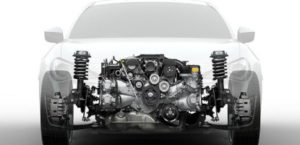EA113 or VW R4 engines
The VW EA113 4-cylinder engine series was first introduced back in 1996 as an evolutionary replacement for the popular EA827 powertrain line. There are many versions of engines, including those with direct fuel injection and turbocharging.
From EA827 to EA113
In 1996, as a result of the modernization of the EA827 series motors, a new line of EA113 appeared. There were a lot of differences, and first of all, the designers got rid of the intermediate shaft, the distributor was replaced by a modern ignition system, the oil pump was driven from the crankshaft.
Junior modifications of 1.6 liters acquired a completely new aluminum cylinder block, there were two knock sensors, but in general, the changes at first were evolutionary. The timing drive remained belt driven, the cylinder head is mostly 8-valve with one camshaft.
The engines had three working volumes, the characteristics of the most popular models in the table.
1.6 liters (1595 cc, 81 × 77.4 mm):
- AEH (8v, injector, 100 hp / 145 Nm);
- AHL (8v, injector, 100 hp / 145 Nm);
- AKL (8v, injector, 101 hp / 145 Nm);
- ALZ (8v, injector, 102 hp / 148 Nm);
- ANA (8v, injector, 101 hp / 140 Nm);
- APF (8v, injector, 100 hp / 145 Nm);
- ARM (8v, injector, 101 hp / 145 Nm);
- AVU (8v, injector, 102 hp / 148 Nm);
- BFQ (8v, injector, 102 hp / 148 Nm);
- BGU (8v, injector, 102 hp / 148 Nm);
- BSE (8v, injector, 102 hp / 148 Nm);
- BSF (8v, injector, 102 hp / 148 Nm).
1.8 liters (1781 cc, 81 × 86.4 mm):
- AGN (20v, injector, 125 hp / 170 Nm);
- APG (20v, injector, 125 hp / 170 Nm);
2.0 liters (1984 cc, 82.5 × 92.8 mm):
- APK (8v, injector, 115 hp / 170 Nm);
- AQY (8v, injector, 115 hp / 170 Nm);
- AXA (8v, injector, 115 hp / 170 Nm);
- AZJ (8v, injector, 116 hp / 172 Nm);
- AZM (8v, injector, 116 hp / 172 Nm);
- ALT (20v, injector, 130 hp / 195 Nm).
- BSX (8v, injector, 109 hp / 160 Nm);
Turbo engines EA113 1.8T
Almost immediately after atmospheric engines, turbocharged units appeared, but at first this only concerned engines that were located transversely under the hood of the car. Longitudinal turbo engines used the old EA827 series block until 2000.
As always, we have summarized the characteristics of the most famous models in a table:
- AGU (20v, injector, 150 hp / 210 Nm);
- AWT (20v, injector, 150 hp / 210 Nm);
- AMB (20v, injector, 170 hp / 225 Nm);
- AWC (20v, injector, 150 hp / 220 Nm);
- AWM (20v, injector, 170 hp / 225 Nm);
- AUQ (20v, injector, 180 hp / 235 Nm).
The units were equipped with a cylinder head with 5 valves per cylinder and a chain drive of the second camshaft; over time, a controlled hydraulic chain tensioner with a phase regulator function appeared here.
EA113 2.0 FSI engines
In 2002, the company introduced 2.0-liter FSI direct injection engines. The cylinder block became aluminum, as before in the 1.6-liter power units, but the main difference was the new 16-valve cylinder head with a full-fledged phase regulator on the intake shaft and, of course, a high-pressure fuel pump for injecting gasoline directly into the engine cylinder.
- BVY (16v, direct injection, 150 hp / 200 Nm);
- BVZ (16v, direct injection, 150 hp / 200 Nm).
EA113 2.0 TFSI engines
In 2004, the designers decided to combine direct injection and turbocharging in one unit. The cast-iron cylinder block was returned for strength, and the crankshaft and other pistons were also reinforced here. The timing drive remained the same, the belt plus the chain, and the phase regulator is only on the intake shaft.
- AXX (16v, direct injection, 200 hp / 280 Nm);
- BPY (16v, direct injection, 200 hp / 280 Nm);
- BWA (16v, direct injection, 200 hp / 280 Nm).
These turbo engines were produced for a short time and since 2007 they began to be replaced by EA888 units. But atmospheric engines of the EA113 series are still being assembled for the developing market.
